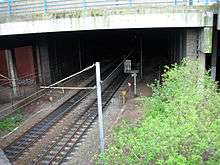Stour Valley Line

The Stour Valley Line is the historic and colloquial name for the line of the Birmingham, Wolverhampton and Stour Valley Railway Company between Birmingham and Bushbury, just north of Wolverhampton in the West Midlands, England. It now forms part of the "Birmingham Loop" or "Rugby–Birmingham–Stafford Line" of the West Coast Main Line. The "Stour Valley" was a branch which was never built, yet it gives its name to the whole section.
The creation of the line was bound up with the Birmingham Canal Navigations Company which owned the BCN Main Line Canal whose route it closely followed between Birmingham and Wolverhampton.
History

The London and Birmingham Railway & Birmingham Canal Navigations Arrangement Act 1846, sponsored by the speculative Birmingham, Wolverhampton and Stour Valley Railway Company, authorised the building of the Birmingham, Wolverhampton and Stour Valley Railway between Birmingham and Wolverhampton.
It was early in the growth of railways. The London and Birmingham line terminated at New Street (then called Navigation Street) and the Grand Junction line from the north west terminated at its southern end at Bushbury.[1] The Birmingham Canal Navigations (BCN), fearing competition from the railway companies, decided to go into a form of partnership in an attempt to survive the new transport revolution. From the railway's point of view, the London and North West Railway Company (L&NW) — having just merged with the London and Birmingham Railway Company — wanted control of the line which would join their London to Birmingham line with their Grand Junction line from Coseley to the north west.[1] The BCN were given a guaranteed dividend. The London and Birmingham Railway were given the right to appoint to the Board of the BCN and influence canal policy.[2] The London and Birmingham merged into the London and Western Railway Company a year later (1847) who actually built the line between 1848 and 1850.[2]
The Birmingham, Wolverhampton and Stour Valley Railway Company, BCN, London and Birmingham Railway (part of L&NW), and Shrewsbury and Birmingham Railway invested equally in building the line.[1]
Robert Stephenson and William Baker were the engineers. Construction started in 1847 from the Birmingham end with a tunnel of 845 yards (773 m) into New Street Station. It was completed on 21 November 1851.[1] Goods trains of the L&NW started on 1 February 1852 followed by passengers on 1 March 1853.[1] The half-hourly service was also a "spoiler" to prevent the competing Shrewsbury & Birmingham Railway Company from running over their tracks, claiming that it would be too dangerous.[1]
Route

In addition to Birmingham and Wolverhampton, stations were planned at Smethwick, Spon Lane, Oldbury & Bromford Lane, Dudley Port, Tipton, Deepfields & Coseley, and Ettingshall Road & Bilston.[3]
There was a planned branch from Dudley Port to Dudley.[1] There was also a planned branch from Smethwick to Stourbridge which was abandoned before the Act was passed although the "Stour Valley" part of the company name persisted.[3]
After the service had been established stations were added at Bushbury (2 August 1852), Albion (near Oldbury) (1 May 1853), Monument Lane (west of the New Street Tunnel) (1 July 1854) and Monmore Green (near Wolverhampton) (1 December 1863).[1]
Sculptures

In 1987 a series of flat steel sculptures of horses, designed by Kevin Atherton, was commissioned by West Midlands Arts, British Rail and four local authorities and placed along the line at a cost of £12,000.[4][5]
Points of interest
The original west (north west) portal of the New Street tunnel, 1846–47, now underneath the National Indoor Arena (at SP0593486846), is a Grade II listed building.[6]
Line
New Street North Tunnel (Stour Valley railway tunnel)
References
- 1 2 3 4 5 6 7 8 Wolverhampton History and Heritage Society - local history
- 1 2 Shill, Ray (2005). Birmingham and the Black Country's Canalside Industries. Tempus Publishing Ltd. ISBN 0-7524-3262-1.
- 1 2 Foster, Richard (1990). Birmingham New Street - The Story of a Great Station including Curzon Street. Vol 2 Expansion and Improvement 1860-1923. Wild Swan Publications Ltd. ISBN 0 906867 79 7.
- ↑ "Iron Horse". Public Monuments and Sculpture Association. Retrieved 18 March 2015.
- ↑ "Kevin Atherton". LUX. Retrieved 18 March 2015.
- ↑ Historic England. "LADYWOOD WEST TUNNEL PORTAL (Grade II*) (1076318)". National Heritage List for England. Retrieved 3 September 2013.
Coordinates: 52°31′30″N 2°02′56″W / 52.525°N 2.049°W